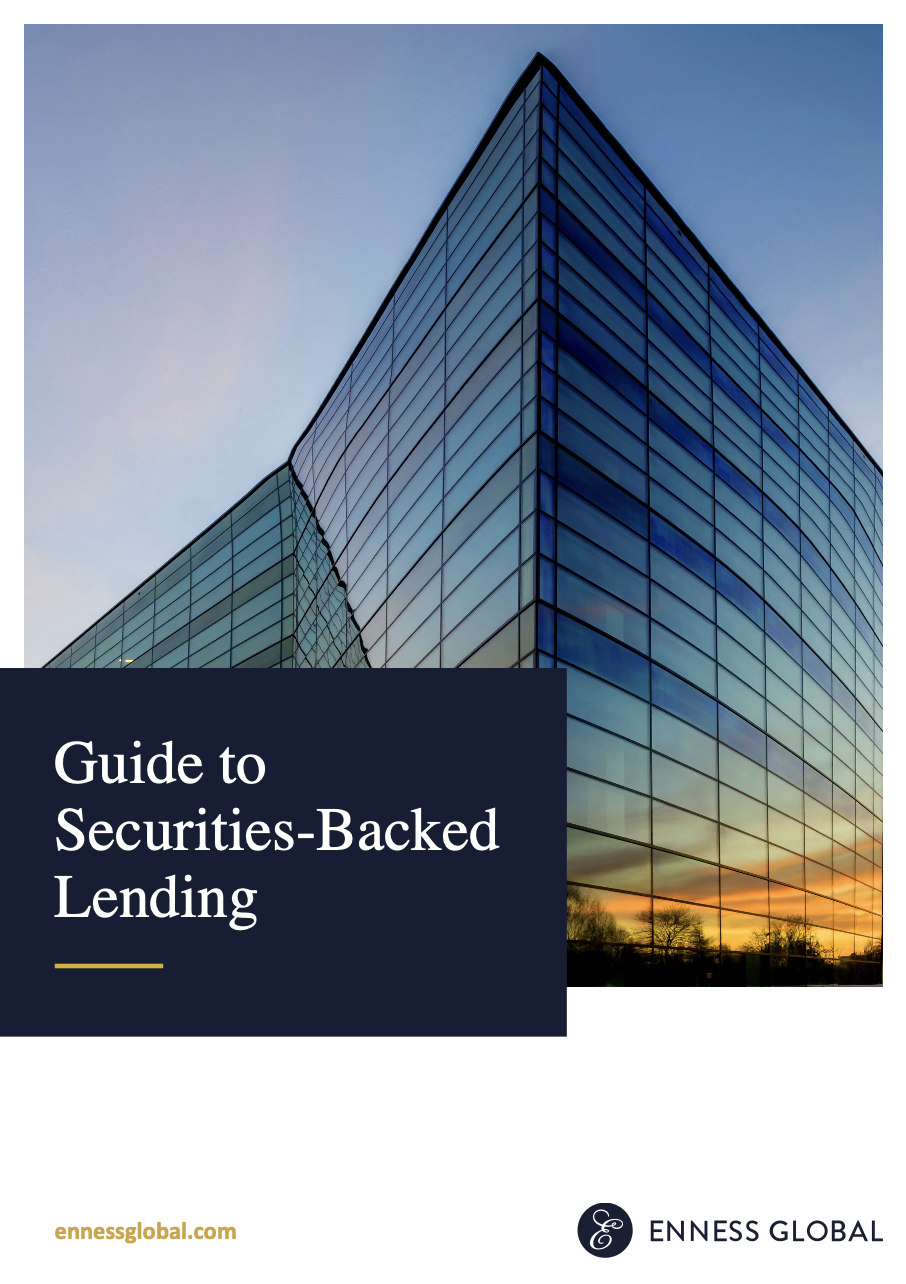What is Securities-Backed Lending?
Securities-backed lending is the practice of using marketable securities or other financial instruments as collateral for a loan.
In essence, you pledge your liquid securities (equities, bonds, investment funds and other types of securities are the most common) in exchange for a credit line from a lender, who uses these securities as collateral. You can use this credit line at any time during a pre-agreed period. Securities lending allows you to increase your liquidity or access capital without having to sell your securities.
Having a line of credit available to you when you need it is one of the many benefits of securities-backed lending. Securities lending is known for being flexible and the underwriting process is quick and straightforward. Capital can be used for a variety of different uses. It’s for these reasons (amongst others!) securities lending is a popular and highly regarded borrowing mechanism.
Contact a Broker Now

How Does Securities-Backed Lending Work?
Securities-backed lending isn’t actually that different from ‘standard’ consumer loans in terms of how they work. The main difference is that securities are used as collateral, rather than other types of assets, or a loan being based on your income or earning power, which is often the case.
Let’s say you own shares with a market value of £10 million in a listed company. You need access to capital, but you don’t want to sell your shares, which wouldn’t be advantageous to you for any number of reasons.
Instead of selling your shares to create the liquidity you need, you can benefit from a securities-backed loan, using your shares as collateral. You can get a securities lending for around 50% of the value of your shares - an amount of approximately £5 million. You can expect to pay about 1% per annum as interest in this kind of scenario.
What Are the Advantages of Securities Lending?
Securities lending can be very advantageous for a number of reasons. Underwriting is often limited to the collateral used as security for the loan, which means the process is highly efficient. In part, it’s this very efficient underwriting process that makes securities-backed lending so popular: you can create liquidity fast and relatively easily.
Selling securities or underlying assets can have an impact on your broader financial situation, creating significant tax charges, for example. Alternatively, if you have to sell securities early or before the ideal moment to create liquidity, you may also miss out on the future upsides of the asset as it grows or pays you dividends, meaning selling isn’t in your best interests. For these reasons, you may not want to sell your securities to raise funds and may want to look at other options, of which securities-backed lending is likely to be one.
Securities lending provides an efficient and flexible alternative to selling your securities. You maintain the long-term benefits of securities ownership without incurring some of the unwanted financial repercussions of selling securities, all while accessing the capital you need.
This type of lending can be ideal if you want to respond to an unexpected opportunity but don’t have the capital you need available in cash. You may also want to consider these types of loan if you encounter an issue or opportunity that you need to solve or pursue.
Which Assets Can be Used for Securities-Backed Lending?
In theory, you can use any financial asset as collateral for securities-backed lending. However, the more liquid and mainstream your financial assets are, the more options and lenders will be available to you.
Enness can help you secure assets-backed lending using the following securities as collateral:
- Portfolios
- Stocks
- Bonds
How Much Does Securities Lending Cost?
Securities-backed lending is always individually negotiated. The interest rate of your loan will mostly depend on the underlying security you are offering as collateral. However, the loan-to-value ratio, the quantum, the asset manager and other factors will affect what interest rates your borrower is likely to offer you.
If you have a diversified portfolio of A-grade stocks at a modest loan-to-value, your loan will be very cheap: around 1% per annum.
On the other hand, a high loan-to-value ratio on a single line of stock listed on a secondary index with low trading volumes will be more expensive by comparison.
It may be helpful to know that securities-backed lending interest rates can also be lower than ‘traditional’ loan rates, making them an interesting option.
However much your securities-backed lending costs, Enness believes it is always worth considering the bigger picture. What constitutes ‘expensive’ securities-backed lending is often contextual. Securities lending may ultimately cost you significantly less than selling your securities before they mature, for example. The cost of a missed opportunity or the cost of a comparable loan using other collateral or financial products should also be considered to get a grasp on how securities-backed lending compares – it is often significantly cheaper than alternative options.
Which Banks Offer Securities-Backed Lending?
There’s no shortage of banks that offer securities-backed lending. Many will happily offer you a loan if you have a certain type of asset and you are a client.
That said, you’ll find that the vast majority of securities-backed loan providers focus on the most vanilla part of the market. In essence, this means they will only offer securities-backed loans collateralised against diversified portfolios and grade A securities.
Enness works with the many lenders who pick up everything else, including more complex or unusual assets or very niche areas of the market. Enness connects borrowers with specialist lenders, private equity houses, alternative financiers and even high-net-worth individuals who offer securities-backed lending.
Timing, presentation, negotiation and access are crucial to securing the best securities-backed lending.
What Are the Limitations of Securities-Backed Lending?
There is always a loan-to-value cap when it comes to securities-backed lending. In short, that means there is always a maximum percentage of the value of your asset(s) that lenders will be willing to let you borrow. Securities-backed lending providers need to be able to absorb volatility or changes in the value of your securities during the period of your loan without making a loss. Because of this, you won’t be able to borrow more than a certain amount against your securities.
Some securities-backed lending providers will also enforce a margin call should the value of a stock fall below a certain amount. In these cases, your loan will need to be repaid, or you will need to provide additional assets that your lender can use as collateral.
Securities-backed lending also has other limitations. These limitations are by no means so restrictive that they make securities-backed lending unattractive or unworkable - after all, many people still use securities-backed finance with much success. However, you will need to understand how limitations will affect you and what room you might have to negotiate. Whether or not you retain voting rights, what happens to dividends, short selling clauses and so on should all be considered carefully. Enness’ broker will explain more about securities-backed lending, including potential risks and what you should think about before going ahead with this type of loan.
How Does Securities-Backed Lending Work?
Securities-backed lending is relatively straightforward. Your securities are pledged to the lender, or alternatively the lender will take custody of your assets. In return, the lender advances a loan to you, using your securities as collateral. You make the interest payments as agreed and stay within the covenants of your loan agreement. Once the loan is repaid, the pledge over the assets is removed.
At any point in the duration of the loan period, the lender may trade your securities, leverage and do other things with your securities as per the loan agreement.
What Is the Underwriting Process for Securities-Backed Lending?
Lenders will look carefully at your securities in the underwriting process for securities-backed lending. The key points a lender will look at are:
- The value of your securities
- What the security is made up of
- The liquidity of the security
- If the security is listed, which exchange it is listed on
- How concentrated the shares are
- The industry or field the company trades in
- The management team
How Quickly Can You Get Securities-Backed Lending?
Securities-backed lending is particularly advantageous because it’s possible to receive your credit line relatively quickly. Comparatively, the underwriting process on something like a mortgage can take a while (because the lender needs to value the property). However, the underwriting process for securities-backed lending is much more straightforward because underwriting is usually limited to the collateral used as security for the loan. It’s this very efficient underwriting process that makes receiving capital so quick. In some cases, you might have access to your credit line in as little as 24 hours or a matter of a few days.
That said, knowing which lenders to approach, how to present your situation and how to settle an advantageous deal is critical. With access to the right lenders and a track record of negotiating the best securities-backed lending terms and deals against different types of security, Enness is ideally positioned to help you get the best loan.
How Do You Apply for Securities-Backed Lending?
Enness will start by discussing your needs, situation and helping you decide if securities-backed lending is the right option for you. If it is, your broker will then approach lenders to negotiate a securities-backed loan and terms on your behalf. The lenders that Enness approaches on your behalf will depend on the securities you hold, how much you want to borrow and the other details of your situation. When it comes to the application process itself, Enness will work alongside you to ensure everything moves quickly and smoothly.
You’ll start by identifying the trading symbol of the securities you want to use as collateral for securities-backed lending. You will also specify the number of securities you wish to pledge to the lender if you are only using part of your assets as collateral or if you are pledging various equities.
Additionally, you will also provide your ID, banking and brokerage details. The lender will use this information to make sure you meet all the AML, KYC, reporting and other regulatory obligations that apply. The underwriting process then commences, and the lender evaluates your securities. Each securities-backed lending provider will have its own set of trading and liquidity standards that you will need to meet. These are entirely at the discretion of the institution and will vary from lender to lender. The lender will also check that your stocks are in proper custodial format.
When securities-backed lending is approved, you will need to electronically transfer your securities into the lender’s designated custodian account. The lender will verify receipt of the securities and then fund your transaction per the terms of your loan agreement.
For securities-backed lending and repo transactions, you can recover possession of the securities at the loan or transaction maturity date. Either you will need to repay the principal balance of the loan, or you can repurchase the securities at an agreed-upon discounted rate.
What Can You Use Securities-Backed Lending for?
Because the application process for securities-backed lending is relatively straightforward and quick, it can be faster to apply and receive securities-backed lending than to obtain a green light on a mortgage. It’s for this reason that securities-backed lending is often associated with property financing. Securities-backed lending can be particularly useful if you want to buy an investment property or second home very quickly and you wish to bypass the mortgage application process for any number of reasons. Securities-backed lending can also be used to your advantage if you are competing to buy a property against cash buyers.
While securities-backed lending is often employed in property financing, it is also used in other situations. Borrowers might choose to use securities-backed lending to reinvest in the stock market, to diversify a portfolio of single stocks or simply as a much-needed cash injection to cover an emergency or opportunity. Entrepreneurs or business owners often use securities-backed lending to leverage opportunities or start a business-related scheme, project or plan.
In scenarios where the proceeds of securities-backed lending is used to reinvest or diversify a portfolio, there is always an inherent risk. Asset prices and investments can fluctuate or lose value. You will need to make sure you can continue to make repayments on your loan should this happen or if your lender enforces a margin call. Ultimately, what you use securities-backed lending for will depend on your needs, expertise, broader financial situation and appetite for risk.
Who Is Eligible for Securities-Backed Lending?
Every lender has its own eligibility standards for securities-backed lending. Some lenders are also more flexible than others. As a general rule, however, you will need to have an investment portfolio of at least £100,000 before a lender will consider you for this type of financing. Some institutions may require that your portfolio is more significant than this. Lenders will also have other criteria you - or your securities - will need to meet before you are eligible for securities-backed lending from their institution.
Enness works with clients - and lenders - from around the world, and many offer securities-backed lending in a variety of different currencies for your ease and convenience. Lenders are used to working with international borrowers who have multiple business interests, investments, and income streams, and as a result, securities-backed lending is a truly global solution. Most lenders are open to working with borrowers of any nationality.
What Is the Maximum Duration of Securities-Backed Lending?
Securities-backed lending varies in duration, but it is generally regarded as a short-term borrowing solution. In some cases, you might need securities-backed lending for a very short period - just a few days or weeks isn’t at all unusual.
At the longest, securities-backed lending typically runs for around 24 months. There’s no maximum timespan, and your loan could run for a little bit longer than this - there isn’t a cut-off or cap you need to keep in mind. However, if you need a longer-term financing solution, Enness' brokers will be able to advise you if securities-backed financing is your best choice. If you decide that securities-backed lending isn't the right option for you, Enness will present you with alternative solutions, possibilities, and lenders to meet your financing needs.
How Much Can You Borrow with Securities-Backed Lending?
Very generally, most institutions will offer securities-backed lending at around 50% of the value of your securities (i.e., a £5 million loan collateralised against securities with a marketable value of £10 million). In some cases, you will be able to get a little more, but this will depend on your situation and securities and will very much be at the lender's discretion.
The type of securities you own, how much you want to borrow, and the terms of your loan may also influence the amount you can borrow.
How Much Interest Do You Pay on Securities Lending?
Securities lending can be very attractive from a cost perspective. Especially compared to more ‘mainstream’ lending (i.e., consumer loans, credit cards, etc), securities-backed lending can be very cost effective, and they are often much cheaper in terms of comparable interest rates.
The interest rate you’ll pay for securities lending is typically tied to LIBOR or a standard base rate. The lender adds its margin on top of this. Interest rates will depend on your securities, your financial situation and the overall risk of the transaction. Securities-backed lending is granted on an individual basis, and as a result, there’s no standard interest rate. Very broadly, however, you can expect typical Lombard loan interest rates to sit between 2% and 5%, although there will be deals where the interest rates fall outside of this bracket.

How Does Enness Help Clients With Securities Lending?
Enness helps clients in a variety of ways, which includes:
- Providing access to a large number of lenders to choose from
- Always acting in clients’ best interests and negotiating the best outcome on their behalf
- Analysing all assets to find clients’ the best lending solution
- Being closely connected to key decision-makers in the industry
- Having international coverage
- A proven track record with both straightforward securities-backed financing and complex or unusual assets
Guide to Securities Backed Lending
Securities-based lending provides ready access to capital. From purchasing a property, buying assets, investing in stocks or growing a business, you can use securities-backed lending (also known as Lombard loans) for various purposes.
Securities-based lending can be an exceptionally useful tool for creating liquidity quickly. As well as more “traditional” Lombard loans against a diverse portfolio of liquid, listed securities, Enness can also broker more unusual deals. This includes sourcing and negotiating loans against unlisted stocks, single stocks and pre-IPO loans.
Lenders in this space provide funding while using the securities available to a borrower. These loans are typically used to access liquidity quickly, allowing investors to take advantage of time-sensitive opportunities.
Building up a representative portfolio to gain access to this lending space change can be challenging. Enness has a proven track record in acting in clients’ best interests and negotiating the best outcome on their behalf.







